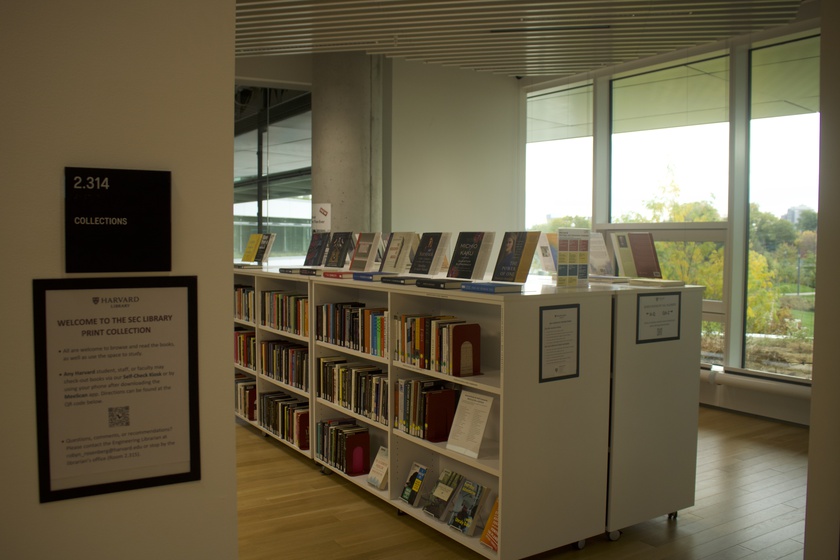{shortcode-27e653206e342c056a6e77e252cadd4d6abc3f21}
{shortcode-24643cedbe14221289878261864001a8ceef067a}n the second floor of the Science and Engineering Complex, there is a small area that you may not expect to find in an engineering building: a specially curated library collection. Though the library may seem incongruous with the rest of the building, it was a planned part of the SEC from the start and is just as innovative as the technology created in it.
The newest of Harvard’s libraries, the SEC library is home to a collection of books that spans numerous disciplines, depicts various histories of science and technology, and highlights STEM figures of different backgrounds (race, sexuality, ability). It is diverse in many ways, even in genre, including graphic novels, poetry, and memoirs.
Robyn Rosenberg, the engineering librarian at the SEC library, curated the collection from scratch. Rosenberg held the same position at Cabot Science Library, and began planning the SEC collection long before the SEC was open to the public.
A quarter of the texts in the SEC Print Collection, which comprises 800 works and counting, are currently checked out. Titles in the collection range from “More than a Glitch: Confronting Race, Gender, and Ability Bias in Tech” to “The Rediscovery of America: Native Peoples to the Unmaking of U.S. History” to “Cracking the Coding Interview” to “Persepolis.” Many of the books included in the collection were released in the past four years, and vary from books on cultural history to titles from the Harvard Science Book Talks series.
“A lot of these books are written by non-white men, and we’re having a lot of international authors, women authors,” Rosenberg says. “We’re not just concentrating on one point of view, which could be more in traditional computer science texts.”
According to Rosenberg, the diversity of the perspectives highlighted in the collection reflects Harvard Library’s broader commitment to equity, diversity, inclusion, belonging, and antiracism. Rosenberg rotates the titles showcased on top of the shelves each month to align with the University’s office for Equity, Diversity, Inclusion, and Belonging’s Heritage and Awareness Calendar.
She notes that the Harvard Library system created a position for a librarian for antiracism in 2021, which is currently held by Jerome Offord Jr. Harvard Library also appointed Jehan Sinclair as their first anti-Black racism librarian and archivist in 2020.
As Rosenberg works in the library, many students, faculty, and administrators regularly “go out of their way” to express their appreciation for different aspects of the collection, especially books or authors that surprised them or made them feel represented.
{shortcode-7607059f223eadb3ec491523c0365f8cd93b9f6c}
About once a week, Katy I. Gero, a post-doctoral research fellow studying how writers use computer-generated text, stops by to peruse the collection.
“One of the things that’s really nice about this collection is it’s quite small,” she says. Instead of being faced with “a hundred books that are all on the same topic,” Gero appreciates that the books have already been thoughtfully selected, noting, “it’s a little bit more like a bookstore in a way.”
Hannah E. Gadway ’25, a Crimson Arts editor and History and Literature concentrator, is a frequent SEC library patron.
“I feel like it’s underutilized by humanities majors,” she says. Gadway says the library’s unique self-checkout system is particularly helpful: “It’s really, really convenient, so you can go there and get your books and it’s all very fast.” The library also has lockers to facilitate efficient deliveries from other Harvard libraries. “I actually prefer to go over there even though it’s kind of far away,” she says.
The library area also contains a study and collaboration space where students can work on their problem sets.
Sean Yang ’24, a Computer Science concentrator, has passed by the SEC library collection many times. Despite having “popped in and taken a look,” he has never checked anything out. “CS classes almost never assign physical reading. It’s always PDFs,” Yang says,
Computer Science professor Stephen Chong says while it is useful to have a physical library in the engineering building, he still accesses material mainly digitally through the University Library for his work.
“The services the library provides in the SEC go beyond a large pile of physical books that you can go and get,” he says. “Thinking about what libraries mean in a university in this day and age, I think it’s exciting that they’re kind of exploring.”
“I feel like it’s very unclear, like what exactly the SEC library is, but I do know that they have those books,” says Computer Science and Psychology concentrator Nithya Gottipati ’25. She believes that many of her peers haven’t yet engaged with the collection because it is not part of their coursework.
“The CS classes here are pretty focused on just a technical aspect of STEM and it’d be nice to have a humanities component as well,” Gottipati says.
Rosenberg says many who are unfamiliar with the library don’t know where to begin. “I think when people come in and they don’t know what they’re looking for, they do say something about computer science or business,” she says.
Coming from a background in anthropology, Rosenberg believes that engaging with topics typically considered to be outside of the science and engineering purview can be helpful for any profession. Through her curation of the collection, Rosenberg hopes “to foster creativity, empathy.”
— Magazine writer Rachel C. Auslander can be reached at rachel.auslander@thecrimson.com.


